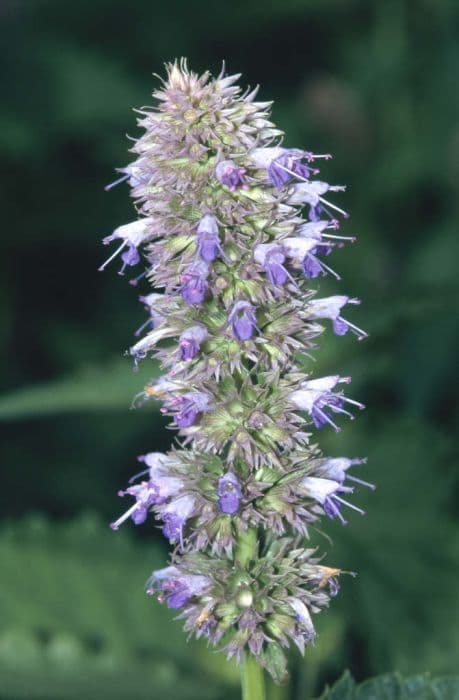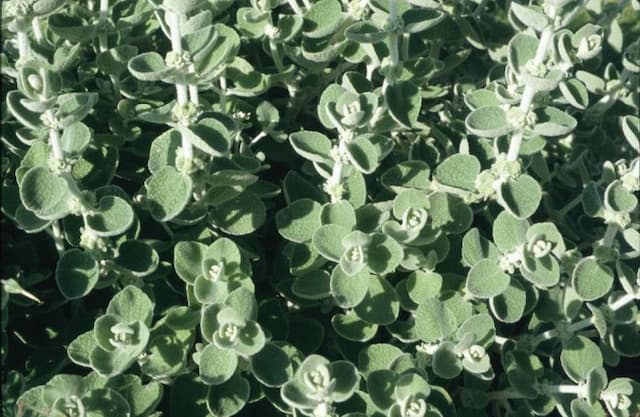Korean mint Agastache rugosa

ABOUT
Agastache rugosa, commonly known as Korean mint, is an aromatic herb with a distinct upright and bushy appearance. Its leaves are roughly oval to lance-shaped and arranged in opposite pairs along the square stems, often with a crinkled texture and serrated edges, showing off a vibrant green hue. The plant is adorned with whorls of small, tubular flowers blooming close to the stems, creating a spiky inflorescence. These flowers are generally a mix of purple and blue shades, which can attract bees and butterflies. Korean mint's foliage is notable for its pleasant fragrance, which is released when the leaves are brushed or crushed. The overall appearance of the plant is one that gives a lush and textured look to gardens, with its notable flowers standing out against the full greenery of the leaves.
About this plant
 Names
NamesFamily
Lamiaceae
Synonyms
Korean Mint, Blue Licorice, Purple Giant Hyssop, Wrinkled Giant Hyssop, Huo Xiang
Common names
Agastache rugosa var. albiflora, Agastache formosana, Agastache rugosa f. albiflora, Lophanthus rugosus, Dracocephalum rugosum.
 Toxicity
ToxicityTo humans
Korean mint, or Agastache rugosa, is generally not toxic to humans. It is actually used in traditional medicine and as a culinary herb in many parts of the world. Ingesting normal food amounts of Korean mint is likely safe for most individuals. There are no well-documented symptoms of poisoning from Korean mint for humans as it is not considered poisonous. However, as with any plant or herb, consuming it in excessive amounts could potentially cause gastrointestinal discomfort or allergic reactions in sensitive individuals.
To pets
Korean mint is also not known to be toxic to pets. It is not listed as a poisonous plant for animals by major pet poison control resources. Consequently, if a pet such as a dog or cat were to ingest a small amount of Korean mint, it is unlikely to experience poisoning. However, ingestion in large quantities might result in mild gastrointestinal upset, similar to what can occur when pets eat plants that are not part of their normal diet. It's always best to monitor your pets and keep them from ingesting large amounts of any non-food plant material.
 Characteristics
CharacteristicsLife cycle
Perennials
Foliage type
Deciduous
Color of leaves
Green
Flower color
Purple
Height
2-3 feet (60-91 cm)
Spread
1-2 feet (30-60 cm)
Plant type
Herb
Hardiness zones
5
Native area
Asia
Benefits
 General Benefits
General Benefits- Culinary Uses: Agastache rugosa, commonly known as Korean mint, is used in Asian cuisine for its aromatic leaves that add a unique flavor to dishes.
- Attracts Pollinators: Korean mint is known for attracting bees, butterflies, and other pollinating insects, which is beneficial for the garden ecosystem and pollination of crops.
- Aesthetic Appeal: With its tall spikes of purple flowers, Korean mint adds a splash of color to gardens and can be used in ornamental borders or as a feature plant.
- Fragrance: The leaves and flowers have a strong, pleasant fragrance that can be enjoyed in the garden or when used in potpourri and sachets.
- Drought Tolerance: Korean mint is drought-tolerant once established, making it a good choice for water-wise gardens.
- Pest Repellent: The aromatic properties of Korean mint are said to help repel certain pests, thereby protecting other plants in the garden.
- Easy Propagation: It can be easily propagated from seed or cuttings, allowing gardeners to multiply their plants without much effort.
 Medical Properties
Medical Properties- Antimicrobial: Agastache rugosa has been shown to exhibit antimicrobial properties against various pathogens.
- Antioxidant: The plant contains compounds that possess antioxidant activities, helping to neutralize harmful free radicals in the body.
- Anti-inflammatory: It has been used traditionally to reduce inflammation, potentially aiding in the treatment of inflammatory conditions.
- Gastrointestinal relief: Often used in traditional medicine to alleviate symptoms of indigestion, nausea, and vomiting.
- Antipyretic: Agastache rugosa may help reduce fever, a common usage in some traditional medicine practices.
- Anxiolytic effects: There is evidence to suggest that it may have a calming effect, potentially helping to reduce anxiety.
- Diaphoretic: Traditionally used to induce sweating, which can help in the management of fevers and colds.
- Carminative: May help in relieving symptoms of gastrointestinal distress, such as gas and bloating.
 Air-purifying Qualities
Air-purifying QualitiesThis plant is not specifically known for air purifying qualities.
 Other Uses
Other Uses- Insect Repellant: Agastache rugosa, commonly known as Korean mint, can be used to naturally repel insects due to its strong fragrance.
- Companion Planting: Korean mint is sometimes planted in gardens to deter pests from other plants and attract beneficial insects like bees and butterflies.
- Culinary Flavoring: The leaves of Korean mint can be used fresh or dried to add a unique flavor to dishes, particularly in Korean cuisine.
- Ornamental Use: With its attractive flowers and pleasant scent, Korean mint is often grown in ornamental gardens for aesthetic purposes.
- Fragrance Production: The essential oil from Korean mint can be used in the production of natural fragrances for perfumes or room fresheners.
- Potpourri Ingredient: Dried leaves and flowers can be incorporated into potpourri mixes, adding a fresh and minty aroma to the blend.
- Dye Source: The plant can be used as a natural source of dye for fabrics, although it is not among the most common dye plants.
- Beverage Infusions: Korean mint can be used to add an aromatic touch to beverages, such as teas or cocktails.
- Cooking Herb: The strong, aromatic leaves can be used to season meats or as part of marinades to impart a minty flavor.
- Religious and Cultural Uses: In some cultures, Korean mint plants may have symbolic meanings and are used in various rituals and ceremonies.
Interesting Facts
 Feng Shui
Feng ShuiThe Korean mint is not used in Feng Shui practice.
 Zodiac Sign Compitability
Zodiac Sign CompitabilityThe Korean mint is not used in astrology practice.
 Plant Symbolism
Plant Symbolism- Healing: Agastache rugosa, also known as Korean mint, is often associated with healing due to its medicinal properties and use in traditional remedies.
- Balancing: Korean mint is believed to help balance energies within the body, which makes it symbolize harmony and equilibrium.
- Peace: The soothing scent of Korean mint is thought to bring about a peaceful state of mind, thus it is often related to tranquility.
- Restoration: Due to its invigorating fragrance and effects, Korean mint can represent restoration, especially in terms of vitality and zest for life.
 Water
WaterKorean mint (Agastache rugosa) should be watered regularly, ensuring the soil remains moist but not waterlogged. During the growing season, aim for about 1 inch of water per week, either through rainfall or manual watering. This is roughly 0.6 gallons for a small-medium sized plant. Reduce watering frequency in winter when the plant is dormant. Ensure proper drainage to prevent root rot, and in hotter, drier climates, you may need to water more frequently.
 Light
LightKorean mint prefers full sun to partial shade. The ideal spot for this plant is an area where it will receive at least six hours of sunlight each day. Morning sun with afternoon shade is beneficial, especially in hotter climates to prevent scorching. However, it will still perform well with slightly less light in a bright, indirect location.
 Temperature
TemperatureKorean mint thrives in temperatures between 60°F and 80°F but can tolerate temperatures as low as 20°F for short periods. The maximum temperature the plant can handle without stress is about 90°F. Protect the plant from frost to prevent damage.
 Pruning
PruningPrune Korean mint to promote bushier growth and prevent legginess, usually in spring or early summer. It's also beneficial to trim the plant after flowering to encourage a second bloom. Pruning frequency should be about once or twice a year, timed with seasonal growth and flowering cycles.
 Cleaning
CleaningNot needed
 Soil
SoilKorean Mint (Agastache rugosa) prefers well-draining soil with ample organic matter, ideally with a loamy texture. The best soil mix would be equal parts garden soil, compost, and perlite or sand to ensure drainage. The soil pH should be slightly acidic to neutral, ranging from 5.5 to 7.
 Repotting
RepottingKorean Mint should be repotted every 2 to 3 years to ensure it continues to thrive. Repotting is best done in the spring months when the plant is emerging from dormancy.
 Humidity & Misting
Humidity & MistingKorean Mint prefers moderate to high humidity levels, with optimal conditions being between 40% to 60% humidity. Avoid excessively dry environments for the best plant health.
 Suitable locations
Suitable locationsIndoor
Place Korean Mint in a bright spot with some direct sun.
Outdoor
Plant in a sunny or part-shade spot with well-draining soil.
Hardiness zone
5-10 USDA
 Life cycle
Life cycleKorean mint (Agastache rugosa) begins its life cycle as a seed, typically sown in late winter to early spring, where it undergoes germination once temperatures and moisture levels are favorable. The seedlings emerge and establish a root system before developing into vegetative plants, characteristically showcasing serrated leaves and a strong stem. During the growing season, Korean mint will enter its flowering phase, producing spikes of purplish-blue flowers that are highly attractive to bees and other pollinators. After pollination, the flowers will set seed, completing the plant's reproductive cycle. As an herbaceous perennial, Korean mint will die back to the ground at the end of the growing season in colder climates, with the rootstock surviving the winter to regrow the following spring. In warmer climates, the plant may remain green year-round but still follows an annual bloom and seed-set pattern.
 Propogation
PropogationPropogation time
Spring-Summer
Korean mint, or Agastache rugosa, is commonly propagated by seed. The ideal time to sow seeds is in late winter or early spring, typically indoors about 6-8 weeks before the last expected frost. To propagate, fill a tray or pots with a well-draining seed starting mix and scatter the seeds on the surface. Press them lightly into the soil but do not cover them, as light aids germination. Keep the soil moist but not waterlogged, and maintain a temperature of around 70°F (approximately 21°C). Seeds usually germinate within 1-3 weeks. Once the seedlings have developed a couple of sets of true leaves and there is no more risk of frost, they can be transplanted into the garden or larger containers.









